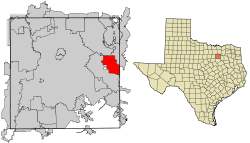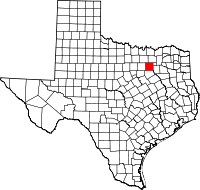Sunnyvale, Texas
| Sunnyvale, Texas | |
|---|---|
| Town | |
 Location within Dallas County and the state of Texas | |
| Coordinates: 32°48′13″N 96°34′11″W / 32.80361°N 96.56972°WCoordinates: 32°48′13″N 96°34′11″W / 32.80361°N 96.56972°W | |
| Country | United States |
| State | Texas |
| County | Dallas |
| Government | |
| • Mayor | Jim Phaup |
| Area | |
| • Total | 16.7 sq mi (43.4 km2) |
| • Land | 16.7 sq mi (43.4 km2) |
| • Water | 0.0 sq mi (0.0 km2) |
| Elevation | 486 ft (148 m) |
| Population (2010) | |
| • Total | 5,130 |
| • Density | 161/sq mi (62.1/km2) |
| Time zone | CST (UTC-6) |
| • Summer (DST) | CDT (UTC-5) |
| ZIP code | 75182 |
| Area code(s) | 214, 469, 972 |
| FIPS code | 48-71156[1] |
| GNIS feature ID | 1348079[2] |
| Website | http://www.townofsunnyvale.org/ |
Sunnyvale is a rural, sparsely populated, affluent town in Dallas County, Texas, United States. It is the easternmost city completely within Dallas County. The population was 5,130 at the 2010 census.[3]
History
The town now called Sunnyvale was inhabited by various Native American tribes in the years before the European conquest of the Americas. It became under the rule of Spain in the 18th century, very close to the boundary of Spanish and French territory (although this boundary was carried upward a bit in 1819; see Adams-Onís Treaty.) During this time, the area was relatively underdeveloped. However, some settlers migrated to Texas and would eventually settle in Sunnyvale. In 1821, the town became a possession of Mexico when Mexico received its independence from Spain. After the Texas Revolution, the area once again changed hands, under the Republic of Texas. This is when the town started to develop. During this time, settlers migrated to present-day Sunnyvale, naming the hamlet they founded Long Creek.1. In 1845 Texas became a United States state. More settlers migrated to the area. In the 1860s, the town was briefly part of the Confederate States of America. As more people arrived, eventually three new towns sprang up in the area: New Hope, Tripp, and Hatterville. New Hope was the most prosperous of these. It had many shops and stores, a fair called Gala Days, and a newspaper, the New Hope News. It was neighboring Mesquite's biggest rival. This all ended in 1921, when a storm blew the town away 2. Many buildings were damaged and the prosperous days were over. From this year on to the 1950s, the four towns had no new developments, remaining stagnant. In the year 1953, the hamlets of Hatterville, New Hope, Long Creek, and Tripp merged under the name Sunnyvale. The name was chosen in a contest from a local school. Today, there are many reminders of Sunnyvale's rich history, like the old New Hope School; the Tripp First Baptist Church, built in 1882; and many antique houses. The Long Creek Cemetery in southern Sunnyvale is over 150 years old, and the first recorded burial there is that of Leona Crownover Caldwell, dated October 2, 1855. There are also veterans from most major American wars, including the War of 1812, the Civil War (both Union and Confederate veterans), the World Wars, and others. Some of the oldest burials in the cemetery include James Truss and Priscilla Dulaney Truss, both born in 1799 2. On December 26, 2015 the town was struck by an EF-4 tornado causing extensive damage to the Plantation RV park, the tornado then grew and moved northeast into Garland and Rowlett killing 12 people and injuring dozens.
Geography
Sunnyvale is located at 32°48′13″N 96°34′11″W / 32.80361°N 96.56972°W (32.803646, -96.569654).[4]
According to the United States Census Bureau, the town has a total area of 16.8 square miles (44 km2), all of it land.
Demographics
| Historical population | |||
|---|---|---|---|
| Census | Pop. | %± | |
| 1960 | 969 | — | |
| 1970 | 995 | 2.7% | |
| 1980 | 1,404 | 41.1% | |
| 1990 | 2,228 | 58.7% | |
| 2000 | 2,693 | 20.9% | |
| 2010 | 5,130 | 90.5% | |
| Est. 2015 | 6,044 | [5] | 17.8% |
As of the census[1] of 2010, there were 5,130 people, 891 households, and 775 families residing in the town. The population density was 160.8 people per square mile (62.1/km²). There were 928 housing units at an average density of 55.4 per square mile (21.4/km²). The racial makeup of the town was 68.4% White, 20.6% Asian, 6.2% African American, 0.4% Native American, 1.9% other races, and 2.7% from two or more races. Hispanic or Latino of any race were 8.7% of the population.
There were 891 households out of which 43.3% had children under the age of 18 living with them, 78.8% were married couples living together, 5.1% had a female householder with no husband present, and 13.0% were non-families. 11.2% of all households were made up of individuals and 4.5% had someone living alone who was 65 years of age or older. The average household size was 3.02 and the average family size was 3.27.
In the town the population was spread out with 29.6% under the age of 18, 5.1% from 18 to 24, 25.7% from 25 to 44, 30.7% from 45 to 64, and 9.0% who were 65 years of age or older. The median age was 41 years. For every 100 females there were 101.1 males. For every 100 females age 18 and over, there were 97.8 males.
The median income for a household in the town was $86,952, and the median income for a family was $98,999. Males had a median income of $63,750 versus $37,297 for females. The per capita income for the town was $38,910. About 2.5% of families and 3.2% of the population were below the poverty line, including 1.1% of those under age 18 and 5.0% of those age 65 or over.
Government and infrastructure
The town council includes four members and the mayor.[7] As of May 2011, Jim Phaup is the mayor of Sunnyvale.[8] As of the same year the council members are Mayor Pro-Tem Karen Hill, Paula Yates, Pat Wiley, Ronnie Henderson, and Saji George.[7]
In 2000 a U.S. district court ruled that Sunnyvale had enacted planning and zoning practices that were in place to exclude the development of apartments and small single family lots. Sunnyvale and the Inclusive Communities Project (ICP) entered into an agreement in which Sunnyvale was given three years to identify 70 housing units favorable for purchase or rent by low income individuals and families. Since 2008, three developers have considered low income developments in Sunnyvale, but no applications have been filed with the Town. ICP filed a lawsuit against Sunnyvale in 2009, seeking the development of low income units at a site in Sunnyvale. Sunnyvale's government responded, saying that it had taken appropriate steps to approve the creation of low income housing. As of 2009 Sunnyvale has no Section 8 residents and no apartment units.[9]
“The Town of Sunnyvale received an order from Honorable Judge Reed O’Connor regarding the Dews vs Town of Sunnyvale case, finding the Town in contempt of court for its failure to implement the Settlement Stipulation in the case by April 15, 2008. The Town has reviewed, and understands Judge O’Connor’s order, yet is clearly disappointed in the ruling, because the Town believes that it did all that was possible to comply with the settlement under the circumstances. But Judge Reed O'Connor found the Town guilty of contempt of court and the town has to July 15, 2011 to comply and make available 70 low income units that qualifies for section 8 vouchers.[10]
Law enforcement services are provided under contract by the Dallas County Sheriff's Department
Sunnyvale is in Texas State House District 113, represented by the Republican Cindy Burkett, a Sunnyvale resident who formerly resided in her native Mesquite.
Education
Sunnyvale Independent School District takes students in Sunnyvale who are in grades Pre-Kindergarten through Grade 12.[11]
Sunnyvale has a public library, located on Tower Place in the northwestern portion of the city.[12]
Parks and recreation
Sunnyvale is along Lake Ray Hubbard, which has recreational activities for Sunnyvale residents.[13]
There are also four parks in the city: Jobson Park, Town Center Park, Samuell Farm North, and Robert Vineyard Park.[14]
References
- 1 2 "American FactFinder". United States Census Bureau. Retrieved 2008-01-31.
- ↑ "US Board on Geographic Names". United States Geological Survey. 2007-10-25. Retrieved 2008-01-31.
- ↑ http://factfinder2.census.gov/faces/tableservices/jsf/pages/productview.xhtml?pid=DEC_10_PL_GCTPL2.ST13&prodType=table
- ↑ "US Gazetteer files: 2010, 2000, and 1990". United States Census Bureau. 2011-02-12. Retrieved 2011-04-23.
- ↑ "Annual Estimates of the Resident Population for Incorporated Places: April 1, 2010 to July 1, 2015". Retrieved July 2, 2016.
- ↑ "Census of Population and Housing". Census.gov. Retrieved June 4, 2015.
- 1 2 "Town Council." Town of Sunnyvale. Retrieved on November 4, 2009.
- ↑ "Mayor." Town of Sunnyvale. Retrieved on November 4, 2009.
- ↑ Leszcyinski, Ray. "Sunnyvale defends efforts on low-income housing." The Dallas Morning News. Wednesday October 28, 2009. Retrieved on November 4, 2009.
- ↑ "Press Release of March 23, 2010." Town of Sunnyvale. Following this decision, the town council has decided to allow low-income housing off of Planers road. However, in October 2013, no such apartments have been completed.
- ↑ "Education." Town of Sunnyvale. Retrieved on November 4, 2009.
- ↑ "Library > Contact Information." City of Sunnyvale. Retrieved on November 4, 2009.
- ↑ "Recreation." Town of Sunnyvale. Retrieved on November 4, 2009.
- ↑ http://www.townofsunnyvale.org/index.aspx?nid=109
